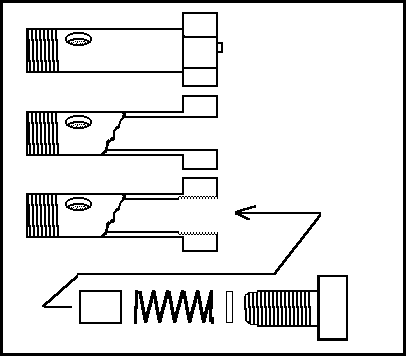
Here are the instructions:
Chuck the old relief valve in a lathe, then machine the pip on the end
"if it has one" flush with the base of the hex.
Use the lathe to "drill" a 3/8 inch ID hole into outside of the hex.
Be carefull,and slow, because when you reach the piston bore, the
spring will want to pop out.
After you get the spring and piston out, debur the inside bore to elliminate
any blemishes from the bore that may impede or even stick the valve open
Tap the new hole with a 7/16 fine tap to just inside the bore 1/16 inch.
Get a brass 7/16 fine bolt and a stainless steel washer that fits inside the
newly tapped hole.
Turn the brass bolt in a lathe to remove the last few threads, so the
brass bolt can be turned beyond the end of the threads.
Radius the end of the bolt so that is captures the stainless washer and
allows the bolt to rotate against the washer like a bearing.
Clean, Clean, Clean all the parts, then install the piston, spring and
washer.
Put a liberal amount of non-hardening threadsealer to the bolt, then
screw it into the valve body until spring resistance is felt.
Turn 2 more turns on the bolt to insure adequate oil pressure for startup.
Install the valve into the filter base, then start the engine. If the pressure
is too high or too low, adjust it immediately. Clockwise rotation will
increase the pressure, and counterclockwise will decrease the pressure.
I recommend adjusting the relief valve to 65 PSI at 3000 RPM.
Oil condition, viscosity and temperature will all effect the operating pressure,
so adjust to whatever condition that you feel is appropriate.
Setting the pressure too high, will put more load on the pump, and could
cause the pump shaft to shear at the pump rotor.
Good Luck!
